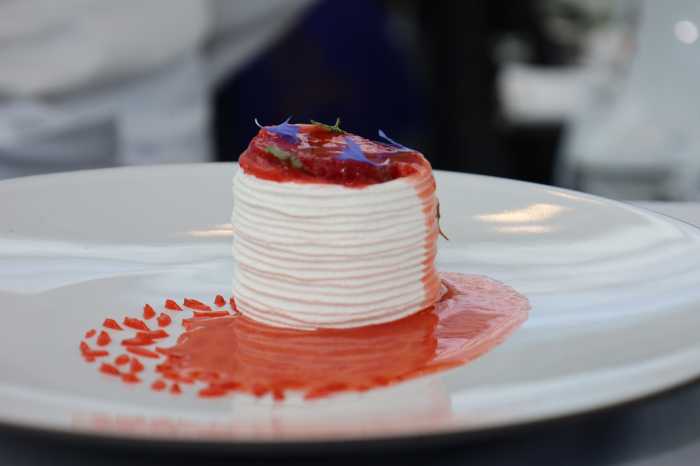Dumplings just make Helen You happy.
The native of Tianjin, China, grew up making the traditional Chinese fare with her mother. The former accountant turned dumplings into a career when she opened Tianjin Dumpling House in the Golden Shopping Mall’s basement food court in Flushing in 2007, drawing lines for her inventive takes on jiaozi.
In 2014, she opened Dumpling Galaxy, a full-service restaurant in Flushing. A rave from the New York Times that year drew the attention of publisher Clarkson Potter, and this month, You shares her tips and 60 recipes for making dumplings and dim sum side dishes in “The Dumpling Galaxy Cookbook” ($19.99; out Jan. 17).
“A lot of people don’t know how to make dumplings, but it’s not as hard as people may think,” said You, who lives in Riverdale. “I wanted to show people how you get to make dumplings, with some clear instructions and inside tips that I learned from my mom or realized by myself.”
You has created hundreds of different dumplings over the years (her restaurant has 100 on the ever-changing menu). The book features recipes for classic dumplings, like pork with chives — a family favorite of You’s — as well as vegetarian options and more creative fare, like pumpkin and black sesame tang yuan — another personal favorite.
You finds inspiration in her loyal customers.
“Customers come and suggest foods, they really inspired me to keep adding more types of dumplings and to meet their demands,” You said. “When they gave me positive feedback, I felt so rewarded, that really inspired me to keep going.”
Regulars will recognize Dumpling Galaxy’s signature creations, such as lamb with green squash, though the book also features some brand-new creations, including salmon with dill.
You wrote the cookbook with Max Falkowitz, an executive digital editor of Saveur and long-time customer.
“She has kept me coming back because her food is so good, and she’s just an interesting, creative cook and she gets really loyal customers,” said Falkowitz, a Queens native who lives in Jackson Heights. “I am in awe every time that I talk with her. She’s constantly challenging herself to make something new.”
Falkowitz spent time watching You make dumplings to understand her thought process, sense of vocabulary and how she manipulates the dough, to help translate that for home cooks. One thing he hopes comes across is the chef’s intuitiveness.
“She has such an effortless and intuitive understanding of how these ingredients come together,” Falkowitz said. “A jaw-dropping moment for me was when she was talking about the way she builds new flavors [and] thinks of everything in ratios. That’s just so natural to her, and it gave me this hope, if we can get people comfortable and get them to feel that same intuitiveness that she feels, then we’ve more than done our job. I think this book has the potential to demystify a lot of questions people have about Chinese food.”
You hopes to further spread her love of dumplings with cooking classes, as well as an international dumpling festival at Dumpling Galaxy.
“We want [it to be like] the United Nations — Polish, Jewish, Indian, German, Argentinian dumplings,” she said. “That’s my next goal.”
Pork and pumpkin dumplings recipe
“Chinese cooks love winter squash,” Helen You writes in “The Dumpling Galaxy Cookbook.” “We usually stir-fry it, cook it into rice porridge (a favorite breakfast of mine) or mash it for crisp and chewy pancakes. But it’s also a happy partner to a pork dumpling filling.”
This winter, warm up with her recipe for these pork and pumpkin dumplings.
Makes 24 dumplings
4 oz. pumpkin or butternut squash, peeled and grated (about 1⁄2 cup)
1 lb. ground pork
2 tbsp. sherry cooking wine
1 tbsp. freshly grated ginger
2 tsp. soy sauce
1⁄2 tsp. kosher salt
24 pan-fried dumpling wrappers (see recipe)
2 tbsp. all-purpose flour
2 tbsp. white vinegar
1 tsp. vegetable oil
1. In a small microwave-safe bowl, cover the pumpkin with parchment paper and microwave for 30 seconds on high until the pumpkin softens but retains some crunch. (Alternatively, steam the pumpkin for 1 minute.) Set aside and let cool.
2. In a medium bowl, use your hands to combine the pork, pumpkin, wine, ginger, soy sauce and salt.
3. Make the dumpling wrappers (recipe below). Holding a wrapper in your palm, use a fork to add about 1 tbsp. of the filling to the center of the wrapper, then lightly pat down the filling with the fork to get rid of any air bubbles.
4. Fold the dumpling into a half-moon, pinching it shut with your thumbs and index fingers, then press the center of the dumpling while pulling on the corners to push out any air bubbles and shape into a curved crescent. Inspect the dumpling for any holes and pinch them shut. Repeat with the rest of the wrappers to make 24 dumplings.
5. In a small bowl, whisk together the flour, vinegar and 1 cup of water until combined to make a slurry. Brush the oil in a medium cast-iron or nonstick skillet and heat over medium-high heat, until the oil starts to shimmer. Add six dumplings with the sealed edges lying flat in the pan, spacing them 1 inch apart, then slowly pour in just enough of the slurry to come one-third of the way up the dumplings.
6. Partially cover the pan, leaving a small gap for steam to escape. Increase the heat to high and cook for 2 minutes for cast iron (1 minute for nonstick). Lower the heat to medium for 2 minutes for cast iron (3 minutes for nonstick). Then lower the heat to low for 2 to 3 minutes for cast iron (3 minutes for nonstick).
7. Cook until the water has evaporated, leaving a paper-thin disk of golden-brown starch on the bottom of the pan. Remove from the heat and slide a thin, flexible spatula around the rim of the pan to loosen the edges of the starch disk, then carefully slide the spatula underneath and flip the disk onto a plate in one piece, crispy side up. Serve immediately, then clean the skillet and repeat with the remaining dumplings.
Pan-fried dumpling dough
Makes 24 wrappers
2 cups all-purpose flour
1⁄8 tsp. kosher salt
3⁄4 cup lukewarm water
1 egg white
1. MIX THE DOUGH. Add the flour to a wide mixing bowl and stir in the salt. Stir in the water and egg white with your fingers. The flour will look shaggy, like biscuit dough; as the dough comes together, run an open palm around the edge of the bowl and fold the flour into the center, spinning the bowl with your other hand as you go, until it all forms a rough clump. It’s fine if there are still pockets of dry flour.
2. KNEAD THE DOUGH. Coat your work surface with a fine dusting of flour and turn the dough out of the bowl. Dust your hands with flour and shape the dough into a fat log about the width of your hand. Knead the dough by pushing your hands and wrists into the log and rolling it forward. Then roll it back and push again. Repeat a few times until the log moves easily, adding more flour if it sticks, then spin the log 90 degrees, shape it into a horizontal log again, and knead a few more times, adding more flour if necessary. Use no more flour than you need to keep the dough from drying out.
As you knead, the dough will get firmer and tougher with a texture reminiscent of a gummy bear. It’s ready when it’s smooth to the touch, like the surface of a pearl, not tacky, with no cracks or pockets of dry flour. There may be some lumps. Put the dough back in your work bowl and cover it with a sheet of plastic wrap. Let it sleep for 15 to 30 minutes. While it relaxes, you can prepare your filling.
3. KNEAD AGAIN. Dust your work surface with a little more flour, then knead it as before. Work out all those lumps; after kneading about 10 times you should have satin-smooth dough that forms a clean ball you can easily push into, like the gel of a shoe insert.
4. PORTION THE DOUGH. Form your dough into a log, dust a dough scraper with a little flour, and cut the dough into four equal sections. Roll each section into a log and chop it into six pieces for a total of 24 balls of dough, each about an inch in diameter. Toss the balls with a light coating of flour and cover with a lightly moistened towel.
5. ROLL THE DOUGH INTO WRAPPERS. Gently smash the balls of dough into flat disks, then lightly roll an Asian-style rolling pin across them to flatten them out a bit more. Hold one disk by its edge and firmly but gently roll your pin from the diskas edge to its center. Roll the same edge a few more times, using more pressure at the edge than at the center. Use your other hand to turn the dough disk and reveal a new edge of the disk; roll again. Continue until all edges are rolled out and the wrapper is about 3 to 4 inches in diameter. Hold your rolled-out wrapper up to a light. If you can see through it faintly, your wrapper is ready to go. Otherwise, keep rolling. Roll the edges to half the thickness of the center of the wrappers.
As you get faster, you’ll notice that all your active hand needs to do is roll the pin back and forth while your other hand just rotates the wrapper. As long as your hands stay in these fixed motions, youall easily make even, round wrappers though they donat need to be perfectly uniform. Place freshly rolled wrappers under a lightly moistened towel to keep them from drying out.




































